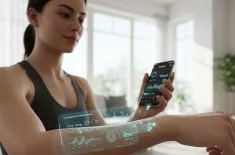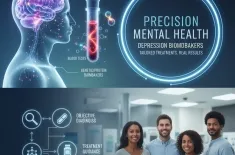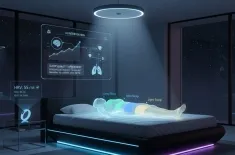Explore how immersive VR is revolutionizing healthcare, offering drug-free pain relief for chronic pain
The modern healthcare landscape is actively seeking innovative, non-pharmacological methods to address two of its most persistent and challenging issues: widespread, debilitating pain and debilitating anxiety and trauma-related disorders. At the forefront of this revolution stands **Virtual Reality (VR)**. Far more than a gaming platform, **immersive VR** technology has evolved into a powerful therapeutic tool, offering patients a safe, controlled, and intensely engaging environment for treatment.
Virtual reality for healthcare, often dubbed "VR Medicine," harnesses advanced technology to create multi-sensory, computer-generated environments. This immersive experience is being applied across a spectrum of conditions, from high-acuity pain events in burn centers to the psychological scars of **PTSD treatment**. Its core appeal lies in its ability to offer a powerful, non-invasive, and **drug-free pain relief** mechanism, addressing patient needs without the side effects or addiction risks associated with traditional pharmaceutical approaches, particularly opioids.
The Science of Distraction: How VR Blocks Pain Signals
At the heart of **VR pain management** is the brain's finite capacity for attention. Pain is not merely a physical signal; it is a complex, subjective experience interpreted by the brain's **neuromatrix**—a network of neurons involving cognitive, affective (emotional), and sensory inputs. This is the mechanism by which **immersive VR** environments deliver their profound analgesic effect.
The Gate Control and Neuromatrix Theories
The effectiveness of VR is rooted in established pain theories:
Gate Control Theory: This theory, first proposed by Melzack and Wall, suggests that non-painful input can close the "gates" to painful input, preventing pain sensation from traveling to the central nervous system. VR provides an overload of non-painful, multimodal sensory input (visual, auditory, and sometimes tactile), effectively hijacking the attention-processing centers of the brain and closing the gate to pain signals.
Neuromatrix Theory: This modern extension posits that pain perception is a pattern generated by the brain's network. VR interferes with this pattern by demanding a massive amount of the brain’s attentional resources. When the brain is deeply engaged in navigating a complex or compelling virtual world—such as flying over an icy canyon or interacting with a friendly virtual character—it simply has fewer resources left to process the nociceptive (painful) signals emanating from the body.
Studies using fMRI (functional Magnetic Resonance Imaging) have provided visual evidence of this process. When patients are immersed in VR during a painful procedure, researchers observe a distinct reduction in activity in the brain regions associated with the pain matrix (such as the thalamus and somatosensory cortex) and an increase in activity in areas related to attention and emotion regulation, like the anterior cingulate cortex.
Acute Pain: A Proven, Immediate Solution
The most robust and clinically accepted application of VR as a **drug-free pain relief** tool is in managing acute pain, especially during highly painful medical procedures.
| Clinical Application | VR Environment Type | Efficacy |
|---|---|---|
| Burn Care & Wound Debridement | SnowWorld (a classic environment of flying through icy canyons) or similar freezing, visually stimulating environments. | Patients report significantly lower pain intensity and unpleasantness scores compared to standard care or non-immersive distraction. |
| Procedural Pain | IV insertion, physical therapy, dental work, minor surgery. | Acts as a powerful cognitive distraction, reducing patient anxiety and the need for high-dose opioids during and immediately after the procedure. |
| Post-Surgical Recovery | Guided relaxation or mild interactive games. | Helps reduce the reliance on breakthrough pain medication and improves patient satisfaction and recovery experience. |
For acute pain, the goal of VR is pure, high-fidelity distraction. The more immersive, interactive, and multi-sensory the experience, the better its analgesic effect.
Addressing Chronic Pain: Beyond Distraction
While the efficacy of VR for acute procedural pain is widely accepted, its role in managing **chronic pain** is different and still rapidly developing. Chronic pain—pain that persists for longer than three months—involves complex psycho-social and neuroplastic changes in the brain. For this population, VR shifts from being a mere distraction to a comprehensive therapeutic tool.
VR for Chronic Pain: A Multi-faceted Approach
In the context of **chronic pain**, VR systems are designed not just to distract, but to facilitate long-term neuroplastic change, integrating principles from cognitive-behavioral therapy (CBT) and physical rehabilitation.
- Exposure and Graded Activity: For conditions like chronic low back pain or fibromyalgia, movement is often painful, leading to avoidance, which ultimately worsens the condition. VR applications can introduce graded, controlled movement within a virtual world. A patient might, for instance, be performing a painful exercise but their mind is focused on catching virtual butterflies or traversing a safe, virtual garden. This allows them to re-associate movement with non-painful, goal-oriented activity, helping to 'retrain the brain' and break the fear-avoidance cycle.
- Cognitive and Emotional Regulation: **Chronic pain** is invariably linked to anxiety, depression, and catastrophizing. Many VR programs for this population incorporate mindfulness, guided meditation, and biofeedback (e.g., controlling a virtual scene with one's breathing or heart rate) to teach patients self-regulation skills. This promotes a shift in the affective (emotional) component of pain, moving toward long-term **drug-free pain relief**.
- Specific Neuropathic Pain: For conditions like phantom limb pain or Complex Regional Pain Syndrome (CRPS), VR can serve as a highly advanced form of mirror therapy, allowing patients to virtually interact with a healthy representation of their limb, promoting beneficial neuroplastic changes in the somatosensory cortex.
While more research is needed to prove lasting analgesia after the VR session is over, the evidence overwhelmingly supports its use for reducing pain intensity and improving functional outcomes during the intervention, making it an invaluable part of a multidisciplinary plan.
Beyond the Physical: VR in Mental Health Therapy
The power of **immersive VR** to convince the brain that "this is real" is precisely what makes it a groundbreaking tool for mental health, particularly for anxiety disorders and trauma. This is where the concept of **exposure therapy** takes on a new, controlled dimension.
Virtual Reality Exposure Therapy (VRET)
Exposure therapy is an evidence-based component of CBT that requires confronting a feared stimulus or memory in a safe environment to allow for a new, non-fearful learning experience (extinction). Historically, this was done *in vivo* (in real life) or *in virtuo* (imaginally), both of which present significant challenges:
- Logistics/Cost: Difficult, costly, or dangerous to replicate scenarios (e.g., flying, combat zones, crowded spaces). VRET provides instant, repeatable, and cost-effective access to an infinite number of highly realistic environments.
- Control: Real-world exposure is unpredictable and cannot be instantly stopped or adjusted. The therapist has complete, instant control over the virtual environment, allowing for precise, graded exposure (e.g., gradually increasing the height of a virtual balcony or the number of virtual spiders).
- Safety and Privacy: Stigma of public exposure (e.g., social anxiety). VRET is conducted privately in a therapist's office, increasing patient acceptance and adherence.
PTSD Treatment and Anxiety Disorders
VRET is proving to be a highly effective treatment for two major areas:
Post-Traumatic Stress Disorder (PTSD Treatment)
For veterans, survivors of accidents, or victims of violence, VRET is used to recreate the traumatic environment—safely and under therapist guidance. One prominent program, **Bravemind**, is specifically designed for military veterans, using sensory inputs like vibrations, smells, and sounds to gradually immerse the patient in a controlled, virtual version of a combat zone. The goal is not to re-traumatize, but to allow the patient to process the traumatic memory in the present moment, thereby reducing the intensity of the emotional and physiological response. This repetitive, controlled exposure leads to habituation and the crucial new learning that the traumatic environment is no longer a threat.
Phobias and Anxiety
VRET is just as effective for specific phobias (like arachnophobia, acrophobia, or aviophobia) and anxiety disorders (like social anxiety). By confronting the fear object (e.g., a virtual spider, a crowd of people, a high bridge) in a space where they know they are physically safe, patients' brains learn that the threat is manageable. Meta-analyses have consistently found that VRET is as effective as in vivo exposure for many phobias, with the added benefits of therapist control and patient preference.
Challenges and the Future of VR Therapy
Despite its impressive successes in both **VR pain management** and mental health, the widespread adoption of VR therapy faces several hurdles.
Implementation and Accessibility Challenges
- Cost and Equipment: While consumer-grade VR hardware is becoming more affordable, clinical-grade systems, software licenses, and necessary accessories (like haptic feedback vests or olfactory emitters) still represent a significant financial investment for clinics.
- Technological Literacy: Clinicians require specialized training to effectively integrate VR into their practice, manage the hardware, and curate the personalized virtual environments necessary for effective **exposure therapy** or complex **chronic pain** programs.
- Adverse Effects: A small percentage of users may experience Virtual Reality Sickness (cybersickness), which includes symptoms like nausea, disorientation, and headaches. While rare with modern, high-quality headsets, it remains a consideration that can interrupt therapy.
The Promising Future
The momentum behind VR is undeniable. Researchers are exploring:
- Neurofeedback in VR: Using real-time EEG or biofeedback data to allow patients to control their virtual environment with their thoughts or physiological state, creating an unparalleled level of self-regulation training.
- AI-Driven Personalization: Integrating Artificial Intelligence (AI) to automatically adjust the intensity of the **immersive VR** experience—whether it’s the complexity of a distraction game for pain or the fear level of a combat scenario for **PTSD treatment**—based on the patient's real-time physiological response.
- Home-Based Therapy: The shift towards at-home VR prescription, making **drug-free pain relief** and anxiety treatment more accessible, allowing patients to perform self-directed, therapeutic exercises from the comfort and privacy of their own homes.
In conclusion, Virtual Reality is transcending its reputation as a niche technology. By leveraging its unique ability to capture and redirect the brain’s finite attention, it provides powerful, non-addictive **drug-free pain relief** for acute suffering. Furthermore, by creating controllable, realistic environments, it is fundamentally changing the delivery of **exposure therapy**, offering a scalable and highly effective solution for **PTSD treatment** and the millions who suffer from **chronic pain**. VR is not merely a distraction; it is a new frontier for healing the body and the mind.



































